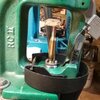Blue68f100
Member
The Redding Type S Sizing die is a FL Body die (sizes from the shoulder down). You can body size loaded ammo with this if for some reason you don't get the shoulder pushed back far enough. You must buy the bushing sizes you need, they do not come with the die. You can also adj how much neck you want to size. Normally you leave a little over sized neck to help center the round when chambered. You should not reduce the necks OD by more than 0.005"-0.006" per stroke. So depending on chamber and weather the necks have been turned you may need to run it through twice. This is one reason to get the neck sizer too.
With a custom chamber you can get the necks so this is not a problem.
With a custom chamber you can get the necks so this is not a problem.







